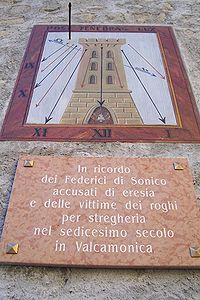
Val Camonica witch trials
Encyclopedia

Witch trial
A witch trial is a legal proceeding that is part of a witch-hunt. * Witch trials in Early Modern Europe, 15th–18th centuries** Salzburg witch trials - 1675-1690, Salzburg, Austria** Spa witch trial - 1616, Belgium...
s which took place in Val Camonica
Val Camonica
Val Camonica is one of the largest valleys of the central Alps, in eastern Lombardy, about 90 km long. It starts from the Tonale Pass, at 1883 metres above sea level and ends at Corna Trentapassi, in the comune of Pisogne, near Lake Iseo...
in Italy
Italy
Italy , officially the Italian Republic languages]] under the European Charter for Regional or Minority Languages. In each of these, Italy's official name is as follows:;;;;;;;;), is a unitary parliamentary republic in South-Central Europe. To the north it borders France, Switzerland, Austria and...
, in 1505-1510 and 1518-1521. They were among the biggest Italian witch trials, and caused the deaths of about 60 persons, in each trial: 110 in total.
The best source for the trials is considered to be the Venetian Marin Sanudo, who was the chronicler to the Council of Ten
Council of Ten
The Council of Ten, or simply the Ten, was, from 1310 to 1797, one of the major governing bodies of the Republic of Venice whose actions were often secretive. Although some sources may indicate that the Council of Ten was generally accepted in Venice, there was some opposition...
from 1496 to 1536. The documentary evidence was destroyed by order of Giacinto Gaggia, the bishop of Brescia, to prevent it from being used by the anticlerical opposition.
Background
Christianity is not considered to have been strong in the area, though it was formally christened in the 400s. In 724, King Liutprando of Lombardy feared a rebellion after he had issued a ban against Paganism. In the laws of 1498, stern laws are issued against all "Devilish heresy". In 1499, it was accused of having participated in a "Black mass", and it was reported to be common with such "depravity" in the area.The first trial 1505-1510
In 1433, witches were burnt in South Tirol, 1460 in Valtellina, and in 1485, the InqusisitorAntonio da Brescia had strongly criticized the ongoing heresy and witch craft in Val Camonica in the Venteian Senate. On 23 June 1505, seven women and one man were burned in Cemmo in Val Camonica, and in 1510, witches were burned who were accused of having caused the drought by magic: 60 women and men confessed having injured people, animals and land with their spells, caused fires with help of Satan: "The whole world mourns for the sad lack of faith in God and the saints in Valcamonica. In four places in Valcamonica, c. sixty four people men and women, have been executed, and many more are placed in prison..."
The Second trial 1518-1521
The second trial occurred after the peace of Noyon with France. During the first months of 1518, inquisitors were stationed in the parishes of the Val Camonica; Don Bernardino de Grossis in PisognePisogne
Pisogne is a comune of 8046 inhabitants in Val Camonica, province of Brescia, in Lombardy.-Geography:Pisogne is situated at the northern-east tip of Lake Iseo....
, Don James de Gablani in Rogno
Rogno
Rogno is a comune in the Province of Bergamo in the Italian region of Lombardy, located about 90 km northeast of Milan and about 40 km northeast of Bergamo, in the Val Camonica....
, Don Valerio de Boni in Breno
Breno
Breno is an Italian comune of 5.014 inhabitants in Val Camonica, province of Brescia, in Lombardy.-Geography:It is bounded by other communes of Bagolino, Bienno, Braone, Ceto, Cividate Camuno, Condino , Daone , Losine, Malegno, Niardo, Prestine.The village of Breno stands in a ravine by the...
, Don Donato de Savallo in Cemmo and Don Battista Capurione in Edolo
Edolo
Edolo is a town and comune in the province of Brescia, in Lombardy, located in the High Camonica valley.The comune is bounded by other communes of Corteno Golgi, Incudine, Lovero , Malonno, Monno, Ponte di Legno, Saviore dell'Adamello, Sernio , Sonico, Temù, Tovo di Sant'Agata , Vezza d'Oglio,...
, all under the bishop Inquisitor Peter Durante, who presided at the central court of the Inquisition at Cemmo. In July 1518, more than sixty women and men were burned at the stake.
In a letter from August 1518, an official, Josef di Orzinuovi, reported of the trial to Ludovico Quercini. He reported that several people had been burned for witch craft after spreading the plague by magic. They were also accused of causing thunder and lightning storms.
The same year, one Carlo Miani, a venetian nobleman, wrote to Dr Zorzi: "Some women in Breto have confessed to have spread powder from Satan through the air, which caused sickness and the death of 200 people..."

